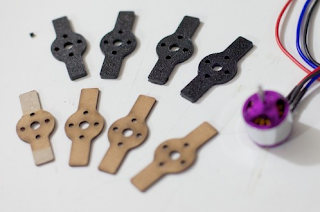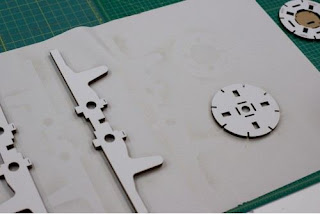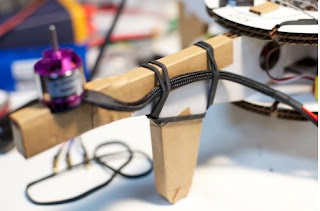AIRBAGS IN AUTOMOBILES
Definition for airbag
An airbag is a vehicle
safety device. It is an occupant restraint system consisting of a
flexible envelope designed to inflate rapidly during an automobile collision. Its purpose is to cushion occupants during a crash and
provide protection to their bodies when they strike interior objects such as
the steering wheel or a window.
Modern vehicles may contain multiple airbags in various side and frontal
locations of the passenger seating positions, and sensors may deploy one or
more airbags in an impact zone at variable rates based on the type and severity
of impact; the airbag is designed to only inflate in moderate to severe frontal
crashes. Airbags are normally designed with the intention of supplementing the
protection of an occupant who is correctly restrained with a seatbelt. Most designs are inflated through pyrotechnic means and can only be operated once.
Terminology
Various manufacturers have over time used different
terms for airbags. General Motors first bags, in the 1970s, were marketed as the Air
Cushion Restraint System (ACRS). Common terms in North America
include Supplemental Restraint System (SRS) and Supplemental
Inflatable Restraint (SIR). These terms reflect the airbag system's nominal
role as a supplement to active restraints, i.e., seat belts. Because no action
by the vehicle occupant is required to activate or use the airbag, it is
considered a passive device. This is in contrast to seat
belts, which are considered active devices
because the vehicle occupant must act to enable them
History
v
In
1951 a German Walter Linderer designed an airbag. It was based on compressed
air system. But later research found that it was not efficient.
v
In
Japan Yasuzaburou Kobori made an airbag in 1963, in which technology current
airbags are based.
v
In 1967, a
breakthrough occurred in the development of airbags when Allen K. Breed
invented a practical component for crash detection.
v In 1971 Ford introduced air bag in their vehicle as an
experimental fleet followed by GM.
v In 1981 Mercedes-Benz introduced airbags in its
S-class
v The first car in the world to have driver and
passenger airbag was Porsche 944 turbo in 1987.
v The first airbag in motorcycles was in 2006 on Honda
Gold wing.
v In 2009, Toyota developed the first production
rear-seat center airbag designed to reduce the severity of secondary injuries
to rear passengers in a side collision.
Typical components used
w Front crash/safing sensors.
w Airbag control module
w Airbag assembly
w Clock springs
w Airbag circuit harness and connectors.
Ø Frond
crash/safing sensor: These devices are usually located in the front grill area.
They are designed to complete a circuit back to the air bag module when a hard
enough crash is measured. Most Safing
sensors will be located inside the air bag control module.
Ø Airbag
control module: The air bag control module is almost always located
inside the passenger compartment. There
are at least 1 and sometimes 2 more safing sensors located inside this unit
that must also close for deployment to occur.
This unit is responsible for sending the deploy command to the air bag.
Ø Airbag
assembly: There could be
as many as 14 of these air bags located throughout the vehicle. The main assembly is located in the steering
wheel. This unit’s main purpose is to
protect the passengers and driver in the event of a crash. These could be inflated at different speeds
depending on size and weight of occupants.
Ø Clock springs: Located inside the steering wheel. This device is used to connect the hard wired
air bag harness to the systems harness while allowing the steering wheel to
maintain a full range of motion.
Ø Airbag
harness & connecters: harness and connecters are yellow
in colour
How
airbags work
The design is conceptually simple; a central "Airbag control
unit" (ACU) (a specific type of ECU) monitors a number of related sensors within the vehicle,
including accelerometers, impact sensors,
side (door) pressure sensors wheel speed sensors, gyroscopes, brake
pressure sensors, and seat occupancy sensors. When the requisite 'threshold' has been
reached or exceeded, the airbag control unit will trigger the ignition of
a gas generator propellant to rapidly inflate a fabric bag. As the
vehicle occupant collides with and squeezes the bag, the gas escapes in a
controlled manner through small vent holes. The airbag's volume and the size of
the vents in the bag are tailored to each vehicle type, to spread out the
deceleration of (and thus force experienced by) the occupant over time and over
the occupant's body, compared to a seat belt alone.
The signals from the various sensors are fed into the Airbag control unit,
which determines from them the angle of impact, the severity, or force of the
crash, along with other variables. Depending on the result of these
calculations, the ACU may also deploy various additional restraint devices,
such asset pre-tensioners, and/or airbags (including frontal bags for driver and
front passenger, along with seat-mounted side bags, and "curtain"
airbags which cover the side glass). Each restraint device is typically
activated with one or more pyrotechnic devices, commonly called an initiator or electric
match. The electric match, which consists of an
electrical conductor wrapped in a combustible material, activates with a
current pulse between 1 to 3 amperes in less than 2 milliseconds. When the
conductor becomes hot enough, it ignites the combustible material, which
initiates the gas generator. In a seat belt pre-tensioner, this hot gas is used
to drive a piston that pulls the slack out of the seat belt. In an airbag, the
initiator is used to ignite solid propellant inside the airbag inflator. The
burning propellant generates inert gas which rapidly inflates the airbag in
approximately 20 to 30 milliseconds. An airbag must inflate quickly in order to
be fully inflated by the time the forward-travelling occupant reaches its outer
surface. Typically, the decision to deploy an airbag in a frontal crash is made
within 15 to 30 milliseconds after the onset of the crash, and both the driver
and passenger airbags are fully inflated within approximately 60-80
milliseconds after the first moment of vehicle contact. If an airbag deploys
too late or too slowly, the risk of occupant injury from contact with the
inflating airbag may increase. Since more distance typically exists between the
passenger and the instrument panel, the passenger airbag is larger and requires
more gas to fill it.
An air bag contains a mixture of sodium azide (NaN3), KNO3, and SiO2.
A typical driver-side airbag contains approximately 50-80 g of NaN3,
with the larger passenger-side airbag containing about 250 g. Within about 40
milliseconds of impact, all these components react in three separate reactions
that produce nitrogen gas. The reactions, in order, are as follows.
(1) 2 NaN3 → 2 Na + 3 N2 (g)
(2) 10 Na + 2 KNO3 → K2O + 5 Na2O + N2 (g)
(3) K2O + Na2O + 2 SiO2 → K2O3Si
+ Na2O3Si (silicate glass)
The first reaction is the decomposition of NaN3 under
high temperature conditions using an electric impulse. This impulse generates
to 300°C temperatures required for the decomposition of the NaN3 which
produces Na metal and N2 gas. Since Na metal is highly
reactive, the KNO3 and SiO2 react and remove
it, in turn producing more N2 gas. The second reaction shows
just that. The reason that KNO3 is used rather than something
like NaNO3 is because it is less hygroscopic. It is very
important that the materials used in this reaction are not hygroscopic because
absorbed moisture can de-sensitize the system and cause the reaction to fail.
The final reaction is used to eliminate the K2O and Na2O
produced in the previous reactions because the first-period metal oxides are
highly reactive. These products react with SiO2 to produce a
silicate glass which is a harmless and stable compound.
According to a patent, the particle size of the
sodium azide, potassium nitrate, and silicon dioxide are important. The NaN3 and
KNO3 must be between 10 and 20 microns, while the SiO2 must
be between 5 and 10 microns.
Triggering
conditions
Airbags are designed to deploy in frontal and near-frontal
collisions more severe than a threshold defined by the regulations governing
vehicle construction in whatever particular market the vehicle is intended for:
U.S. regulations require deployment in crashes at least equivalent in
deceleration to a 23 km/h (14 mph) barrier collision, or similarly,
striking a parked car of similar size across the full front of each vehicle at
about twice the speed. International regulations are performance based, rather
than technology-based, so airbag deployment threshold is a function of overall
vehicle design.
Today, airbag triggering algorithms are becoming
much more complex. They try to reduce unnecessary deployments and to adapt the
deployment speed to the crash conditions. The algorithms are considered valuable intellectual
property. Experimental algorithms may take into
account such factors as the weight of the occupant, the seat location, seatbelt
use, and even attempt to determine if a baby seat is present.
Types of airbags
v
frontal airbag: the normal airbags in the steering wheel and dash
board meant to protect the passenger and driver from head injuries
v side airbag: there are mainly two types
w Side torso airbag: these airbags locate between the occupant and the
door. These are designed to avoid the risk of injury of pelvic and lower
abdomen regions.
w Side tubular or curtain airbags: this airbag was designed to offer head protection
in side impact collisions.
v Knee airbag: this type of airbags are meant for the protection of knee of the occupants on collision.
v Rear curtain airbag: this is to protect the head of the rear occupants
on collision
v Center airbag: this is meant to avoid the second injuries of the rear occupants on side
collisions.
v
Seat belt airbag: these are seen at the seat belts to protect the
body on collisions.
Airbag replacement
If you have been through an accident and
you are safe just because of the airbags been deployed, along with the car
repair, you will also have to consider replacing the airbags. Replacing airbags
is the only alternative left if they have already been used for driving safety.
Considering the benefits that you get from airbags in your car, the replacement
cost seems very low in comparison with the protection and road safety offered.
Unlike repairs to the other car parts after an accident, airbag replacement
will not cost you a lot out of your pocket. The airbag replacement cost depends
on many different factors such as the make and model of your car, the location
of the airbag, and the kind of product used.
Future updates
Ø
Smart Systems
v
Seat Sensors
ü
Determine size and weight of individual.
v
Optical Sensors
ü
Determines how close and size of occupant/car seat.
ü
Determines which way the car seat is facing.
v
Child-Car Seat Sensors
ü
Determines direction of car seat.
v
Occupant Sensors
ü
Determines if someone is present by measuring for
body heat.
v
Air Bag Curtains
Designed to protect the entire
passenger compartment.
























